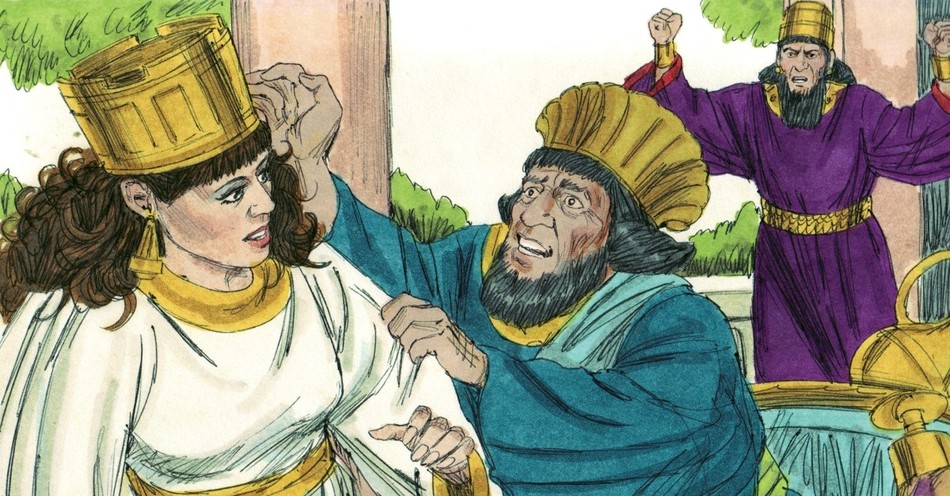Even as Bible villains go, Haman is a particularly bad guy. Even a kid-friendly version of his story, like VeggieTales’ Esther: The Girl Who Became Queen, captures the evil of this man who plotted to wipe out the Jewish population in Ancient Persia.
At the same time, Haman seems throughout the story to be motivated purely by pride and applause. He’s a tragic character consumed with praise to the point where he will kill for it.
So did Haman fight so vehemently against the Jewish people? And why is he important today? We’ll explore these questions and more today.
Who Is Haman in the Bible?
We first meet Haman in Esther 3. We know a few things about this man right off the bat.
V.1. He’s an Agagite. We’ll explain this in a moment, but all you need to know for now is that the Agagites didn’t like the Israelites much.
V.1. He’s honored in the king’s palace. Haman is not only given a high position but one above the nobles. If we know anything about the Persian King Xerxes, we know he didn’t make the smartest decisions. In fact, Xerxes’ decisions ultimately led to his downfall (after the events recorded in the Book of Esther). For some unwise reason or another, Haman is elevated to a high position of honor, where he holds sway over the king’s decisions.
V.2. All the nobles kneel to honor Haman. Well, everyone except Mordecai, Queen Esther’s cousin who works in the palace. We’re never given a reason why Mordecai never bows—probably because he sniffs out Haman’s corrupt character. But we do know that Haman soaks in the praise. He lives off it. To the point where, if someone doesn’t praise him...
V.5-6. Haman decides to kill all the Jewish people in the land of Persia. If you think this is a major overreaction, you’d be correct. Haman was so blinded by his need for approval and honor that he was willing to commit genocide over a slight from one Jewish man.
This sets the stage for the rest of the book. Haman proceeds to convince King Xerxes to sign a law that the Persian people could destroy the Jewish people living in the Persian empire in about a year.
Thankfully, Queen Esther and Mordecai put a stop to this plot. Before we can dive into that, let’s explore Haman’s origins.
Who Were Haman’s Ancestors?
We know already that Haman was a prideful man with an easily wounded ego. However, we need to take in other details given in the Bible. Every country of origin and every characteristic plays an important role in the story as a whole.
What do we know about Haman’s origin? Let’s consult Esther 3:1: “After these events, King Xerxes honored Haman son of Hammedatha, the Agagite, elevating him and giving him a seat of honor higher than that of all the other nobles.”
Let’s hone the phrase Haman son of Hammedatha, the Agagite.
What do we know about Hammedatha?
Not much. His name does mean “He that troubles the law,” according to Hitchcock’s Bible Names Dictionary). Just like his forefather, Haman also troubled the law. He got King Xerxes to sign a document allowing for genocide.
But let’s narrow our focus to the Agagite portion of this description.
Who was Agag? Or who were the Agagites?
Agag was a king of the Amalekites, known enemies of Israel in earlier Old Testament times. The prophet Samuel killed Agag after the Israelite King Saul had Agag spared (1 Samuel 15).
Since we know this, we know that Haman’s family history didn’t take too kindly to Israelites. There are examples of Gentiles in the Old Testament who came to follow Yahweh (like Uriah the Hittite). Some of them (Zipporah, Ruth, Rahab) hailed from enemy territories and yet chose to follow Judaism and Jewish customs.
That would’ve been beneath Haman. His family was already racist toward the Israelites, and one slight from Mordecai pushed him over the edge.
As we mentioned early, Queen Esther does put a stop to this. Just how does she do it?
Through one word: irony.
How Did Esther Get Rid of Haman?
Haman had a plan for how he wanted Mordecai to be killed, one of the most humiliating ways possible: impalement on a stake.
To spare you some gruesome details, let’s just say Ancient Persian stake impaling would’ve been a very painful and slow process. They wouldn’t have just launched the long stake through the heart. It would’ve gone through the entire body.
Before Haman can carry out this plan, Queen Esther has been informed of Haman’s plot for Mordecai and the Jewish people. She knows she’s in somewhat hot (or rather cold) water with King Xerxes. He hasn’t seen her in a while—probably because his harem contains hundreds of women.
Esther knows that if she goes into the king’s presence and he doesn’t extend his scepter to her, that means certain death.
After some convincing from Mordecai, she approaches and invites Xerxes and Haman to dinner.
We can imagine how much this puffed up Haman’s pride to be invited to a special banquet by the Queen. It turns out to be a death sentence.
At the banquet, she informs Xerxes of Haman’s trickery—and since she’s Jewish, Haman would call for her to be wiped out too.
Xerxes flies into a rage and impales Haman on the same stake Haman had set up for Mordecai.
What Can We Learn from Haman in the Bible?
Haman is a prideful and incredibly tragic character in the Book of Esther. He serves as one of the Bible’s most obvious cautionary tales. Although we don’t want to emulate him—as we would prefer not to be genocidal maniacs—we can learn what not to do from his example.
Haman teaches us the dangers of pride. Haman was a very prideful man. So when Mordecai chooses not to bow, Haman’s pride is extremely wounded. It causes him to do something incredibly drastic.
Haman teaches us the dangers of praise. Inherently, there’s nothing wrong with accepting compliments. God has given us many gifts and talents. Many Christians may feel like they have to say, “Well, it wasn’t me, it was God.” And that’s fine to say as well. But there is something to be acknowledged about hard work and putting time into a task. With that said, if we crave praise to the point where we can’t live without it, we may turn into a mini-Haman. Praise blinded him, and he would do anything and everything to ensure he continued getting it—even if that meant committing genocide.
Haman teaches us the dangers of revenge. God is clear that vengeance is his (Deuteronomy 32:35). Even if Mordecai had sinned by not bowing to Haman, that was between him and God. Haman could’ve calmly approached Mordecai and spoken about how he felt Mordecai had slighted him. Instead, he decides he wants to impale Mordecai on a stake. Revenge has a way of acting like poison. We harm ourselves more than we harm others when we use it. The Book of Esther shows us that revenge can literally work against you... Haman receives the punishment he intended for Mordecai.
Haman in the Bible is a sad, sad man whom we hope never to emulate. He’s a good reminder to keep our pride in check and to leave revenge and frustration in God’s hands.
Further Reading:
What Strength Did Queen Vashti and Queen Esther Show?
Who Are the Major People in the Book of Esther?
How Did Mordecai Save God’s People in the Bible?
5 Inspiring Esther Movies You Should See
What Is the Significance of ‘For Such a Time as This’ in Esther?
Photo Credit: Getty Images/BibleArtLibrary
Hope Bolinger is an acquisitions editor at End Game Press, book editor for hire, and the author of almost 30 books. More than 1500 of her works have been featured in various publications. Check out her books at hopebolinger.com for clean books in most genres, great for adults and kids. Check out her editing profile at Reedsy.com to find out about hiring her for your next book project.
This article is part of our Bible resource for understanding the significance and meaning of biblical phrases and ideas. Here are our most popular Bible articles to grow in your knowledge of God's Word:
Promises of God in the Bible
Is "This Too Shall Pass" in the Bible?
What Was the Ark of the Covenant?
Top 10 Bible Stories for Kids
“Iron Sharpens Iron” in Proverbs 27:17
"Fearfully and Wonderfully Made" in Psalm 139
“Be Still and Know That I am God” in Psalm 46:10
"No Weapon Formed Against Me Shall Prosper" - Isaiah 54:17



